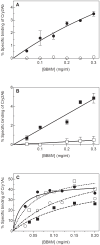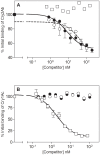Binding site alteration is responsible for field-isolated resistance to Bacillus thuringiensis Cry2A insecticidal proteins in two Helicoverpa species
- PMID: 20376312
- PMCID: PMC2848615
- DOI: 10.1371/journal.pone.0009975
Binding site alteration is responsible for field-isolated resistance to Bacillus thuringiensis Cry2A insecticidal proteins in two Helicoverpa species
Abstract
Background: Evolution of resistance by target pests is the main threat to the long-term efficacy of crops expressing Bacillus thuringiensis (Bt) insecticidal proteins. Cry2 proteins play a pivotal role in current Bt spray formulations and transgenic crops and they complement Cry1A proteins because of their different mode of action. Their presence is critical in the control of those lepidopteran species, such as Helicoverpa spp., which are not highly susceptible to Cry1A proteins. In Australia, a transgenic variety of cotton expressing Cry1Ac and Cry2Ab (Bollgard II) comprises at least 80% of the total cotton area. Prior to the widespread adoption of Bollgard II, the frequency of alleles conferring resistance to Cry2Ab in field populations of Helicoverpa armigera and Helicoverpa punctigera was significantly higher than anticipated. Colonies established from survivors of F(2) screens against Cry2Ab are highly resistant to this toxin, but susceptible to Cry1Ac.
Methodology/principal findings: Bioassays performed with surface-treated artificial diet on neonates of H. armigera and H. punctigera showed that Cry2Ab resistant insects were cross-resistant to Cry2Ae while susceptible to Cry1Ab. Binding analyses with (125)I-labeled Cry2Ab were performed with brush border membrane vesicles from midguts of Cry2Ab susceptible and resistant insects. The results of the binding analyses correlated with bioassay data and demonstrated that resistant insects exhibited greatly reduced binding of Cry2Ab toxin to midgut receptors, whereas no change in (125)I-labeled-Cry1Ac binding was detected. As previously demonstrated for H. armigera, Cry2Ab binding sites in H. punctigera were shown to be shared by Cry2Ae, which explains why an alteration of the shared binding site would lead to cross-resistance between the two Cry2A toxins.
Conclusion/significance: This is the first time that a mechanism of resistance to the Cry2 class of insecticidal proteins has been reported. Because we found the same mechanism of resistance in multiple strains representing several field populations, we conclude that target site alteration is the most likely means that field populations evolve resistance to Cry2 proteins in Helicoverpa spp. Our work also confirms the presence in the insect midgut of specific binding sites for this class of proteins. Characterizing the Cry2 receptors and their mutations that enable resistance could lead to the development of molecular tools to monitor resistance in the field.
Conflict of interest statement
Figures




Similar articles
-
Toxicity and Cross-Resistance of Insecticides to Cry2Ab-Resistant and Cry2Ab-Susceptible Helicoverpa armigera and Helicoverpa punctigera (Lepidoptera: Noctuidae).J Econ Entomol. 2014 Oct 1;107(5):1923-30. doi: 10.1603/EC14230. J Econ Entomol. 2014. PMID: 26309283
-
Insect Resistance to Bacillus thuringiensis Toxin Cry2Ab Is Conferred by Mutations in an ABC Transporter Subfamily A Protein.PLoS Genet. 2015 Nov 19;11(11):e1005534. doi: 10.1371/journal.pgen.1005534. eCollection 2015 Nov. PLoS Genet. 2015. PMID: 26583651 Free PMC article.
-
Characteristics of resistance to Bacillus thuringiensis toxin Cry2Ab in a strain of Helicoverpa punctigera (Lepidoptera: Noctuidae) isolated from a field population.J Econ Entomol. 2010 Dec;103(6):2147-54. doi: 10.1603/ec09289. J Econ Entomol. 2010. PMID: 21309238
-
Monitoring and adaptive resistance management in Australia for Bt-cotton: current status and future challenges.J Invertebr Pathol. 2007 Jul;95(3):208-13. doi: 10.1016/j.jip.2007.03.010. Epub 2007 Mar 25. J Invertebr Pathol. 2007. PMID: 17470372 Review.
-
Resistance of Lepidopteran Pests to Bacillus thuringiensis Toxins: Evidence of Field and Laboratory Evolved Resistance and Cross-Resistance, Mode of Resistance Inheritance, Fitness Costs, Mechanisms Involved and Management Options.Toxins (Basel). 2024 Jul 12;16(7):315. doi: 10.3390/toxins16070315. Toxins (Basel). 2024. PMID: 39057955 Free PMC article. Review.
Cited by
-
Genome evolution in an agricultural pest following adoption of transgenic crops.Proc Natl Acad Sci U S A. 2021 Dec 28;118(52):e2020853118. doi: 10.1073/pnas.2020853118. Proc Natl Acad Sci U S A. 2021. PMID: 34930832 Free PMC article.
-
Shared and Independent Genetic Basis of Resistance to Bt Toxin Cry2Ab in Two Strains of Pink Bollworm.Sci Rep. 2020 May 14;10(1):7988. doi: 10.1038/s41598-020-64811-w. Sci Rep. 2020. PMID: 32409635 Free PMC article.
-
In vivo and in vitro binding of Vip3Aa to Spodoptera frugiperda midgut and characterization of binding sites by (125)I radiolabeling.Appl Environ Microbiol. 2014 Oct;80(20):6258-65. doi: 10.1128/AEM.01521-14. Epub 2014 Jul 7. Appl Environ Microbiol. 2014. PMID: 25002420 Free PMC article.
-
ABCs of Insect Resistance to Bt.PLoS Genet. 2015 Nov 19;11(11):e1005646. doi: 10.1371/journal.pgen.1005646. eCollection 2015 Nov. PLoS Genet. 2015. PMID: 26583776 Free PMC article. No abstract available.
-
Loop replacements with gut-binding peptides in Cry1Ab domain II enhanced toxicity against the brown planthopper, Nilaparvata lugens (Stål).Sci Rep. 2016 Feb 1;6:20106. doi: 10.1038/srep20106. Sci Rep. 2016. PMID: 26830331 Free PMC article.
References
-
- Nester EW, Thomashow LS, Metz M, Gordon M. 100 years of Bacillus thuringiensis: a critical scientific assessment. 2002. American Academy of Microbiology (Washington DC) - PubMed
-
- James C. Global status of commercialized Biotech/GM crops: 2009. 2009. ISAAA Briefs 41-2009 (International Service for the Acquisition of Agri-biotech Applications, Ithaca, NY)
-
- Tabashnik BE, Van Rensburg JBJ, Carrière Y. Field-evolved insect resistance to Bt crops: definition, theory, and data. J Econ Entomol. 2009;102:2011–2025. - PubMed
-
- Roush RT. Two-toxin strategies for management of insecticidal transgenic crops: can pyramiding succeed where pesticide mixtures have not? Phil Trans R Soc Lond B. 1998;353:1777–1786.
-
- Ferré J, Van Rie J. Biochemistry and genetics of insect resistance to Bacillus thuringiensis. Annu Rev Entomol. 2002;47:501–533. - PubMed
Publication types
MeSH terms
Substances
LinkOut - more resources
Full Text Sources
Other Literature Sources
Research Materials
Miscellaneous

